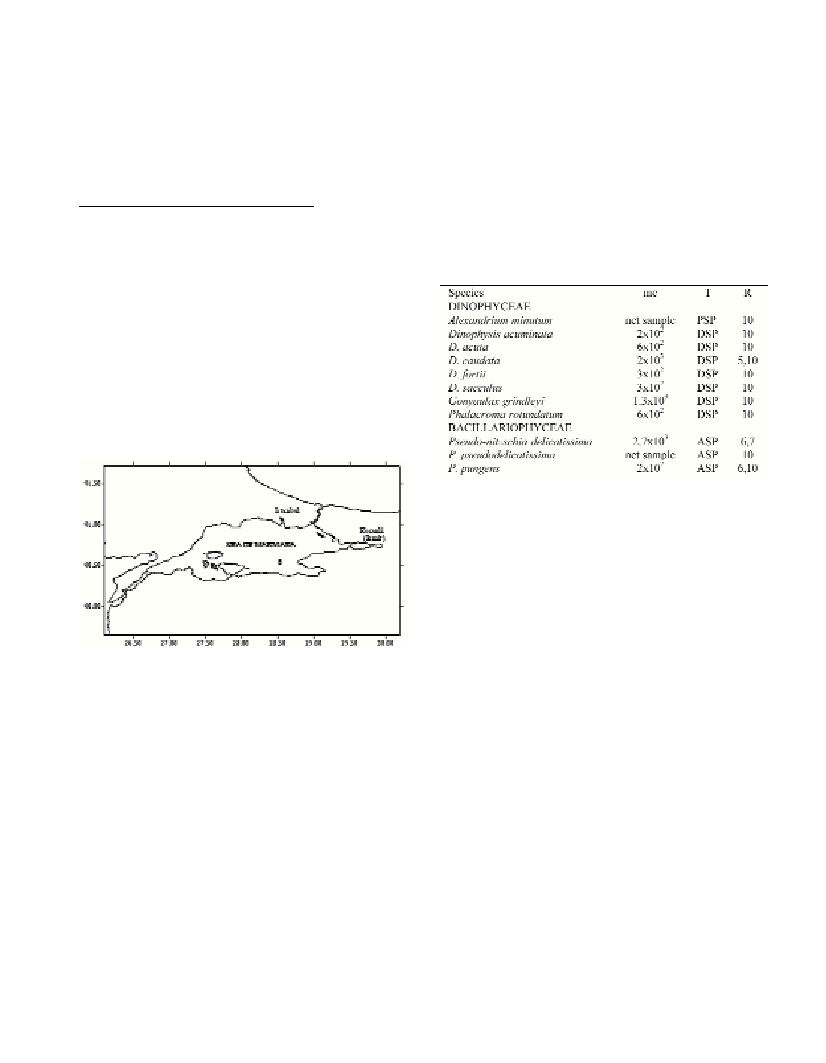TOXIC PHYTOPLANKTONIC SPECIES IN THE SEA OF MARMARA
Neslihan Balkis
1*
and Yelda Aktan
2
1
Istanbul University, Faculty of Science, Department of Biology, Vezneciler-Istanbul, Turkey - * neslbalk@istanbul.edu.tr
2
Istanbul University, Fisheries Faculty, Laleli, Istanbul, Turkey
Abstract
Plankton studies in the Sea of Marmara have been continuing since the 1990s, leading to the identification of 11 toxic species. These
studies did not show a significant increase in the individual numbers of toxic species. The recent change in water quality in the Marmara
Sea suggest a possible increase of density of these species.
Keywords: Toxic micro-algae, Sea of Marmara
Rapp. Comm. int. Mer Médit., 37,2004
486
The Sea of Marmara is a relatively small inter-continental basin
with a surface area 11500 km
2
and a volume of 3378 km
3
(Fig. 1). It
is connected to the Black Sea and the Aegean Sea through the straits
of Bosphorus and the Dardanelles, respectively. The basin is occupied
by two distinctly different water masses throughout the year: one is
the brackish waters (22-26 p.s.u) of Black Sea origin, forming a
relatively thin surface layer (10-15 m thick) with a mean residence
time of ~4-5 months, and the other is the subhalocline waters of
Mediterranean origin (38.5-38.6 p.s.u.) separated from the former by
a sharp interface (pycnocline) ~10-20 m thick [1;2].The chemical
oceanography of the Sea of Marmara is significantly in?uenced by the
biochemistry of the Black Sea and the Aegean Sea. In the upper
euphotic zone, concentrations of nutrients are relatively low and show
seasonal ?uctuations that re?ect the photosynthetic activity [3].Since
primary production is always limited to the less saline upper layer
(15-20 m) of the Sea of Marmara, the subhalocline waters of
Mediterranean origin are always rich in nutrients [4].
Plankton studies in this sea have been continuing since the 1990s
and there are only few data on phytoplankton and their ecological
features [5-10]. A summary of the information on the toxic species in
the Sea of Marmara is given in Table 1. Previous studies in the Sea of
Marmara did not record a significant increase in the individual
numbers of toxic species. The possibility of red-tides is discussed
only in the project studies (unpublished data) of Izmit Bay. These
toxic species reported from the seas of Turkey, caused fish mortalities,
anoxia and hyperoxia in Izmir Bay [11].
The Black Sea has become polluted by river (mainly the Danube)
and wastewater discharges. Because of the large volume of water
in?ow from the adjacent Black Sea (about 600 km
3
) into relatively
small upper layer volume (about 225 km
3
) of the Sea of Marmara, the
upper layer ecosystem of the latter has been in?uenced to a large
extent [1;2].In the next years, an increase in the abundance of these
species may be observed. For this reason, these species should be
monitored carefully by the studies programmed in this region, due to
the dangerous effects of toxic algal blooms on human and ecosystem
health, causing great economic damage to aquaculture and tourism.
The aims of this study are to constitute a toxic species list and to
update the regional records on this basis.
References
1-Unlüata U., OguzT., Latif M.A. and Özsoy E., 1990. On the physical
oceanography of the Turkish Straits. pp. 25-60. In Pratt L.J. (ed.), The
physical oceanography of sea straits. Kluwer, Dortrecht,
2-TugrulS. and Polat S.C., 1995. Quantitative comparison of the in?uxes
of nutrients and organic carbon into the Sea of Marmara both from
anthropogenic sources and from the Black Sea. Pergamon, Wat. Sci. Tech.,
32 (2), 115-121.
3-BastürkÖ., Saydam A.C., SalihogluI. and Yilmaz A., 1986.
Oceanography of the Turkish Straits.III, health of Turkish Straits,
II:chemical and environmental aspects of the Sea of Marmara. METU,
Erdemli-Içel, 86 p.
4-Polat, S.C., Tugrul, S., Çoban, Y., Bastürk, O. and Salihoglu, I. (1998)
Elemental composition of seston and nutrient dynamics in the Sea of
Marmara. Hydrobiologia, 363, 157-167.
5-Aubert M., Revillon P., Aubert J., Leger G., Drai C., Arnoux A. and
Diana C., 1990. Transfert de polluants entre la mer Noire, la mer de
Marmara et la mer Egée. Mers dEurope. Etudes Hydrobiologiques,
Chimiques et Biologiques, Tome 3, C.E.R.B.O.M. (Nice), 47 p.
6-Uysal Z., 1996. A net-plankton study in the Bosphorus junction of the
Sea of Marmara. Tr. J. of. Botany, 20, 321-327.
7-Uysal Z. and Ünsal, M., 1996. Spatial distribution of net diatoms along
adjacent water masses of different origin.Tr. J. of. Botany, 20, 519-525.
8-Tüfekçi V. And OkusE., 1998. Karadeniz-Istanbul Bogazi kistagi,
bogaz ve bogazin Marmara Denizi çikisindaki fitoplankton dagilimi.
Büyüksehirlerde atiksu yönetimi ve deniz kirlenmesi kontrolu
sempozyumu. 18-20 Kasim 1998, ISKI, 157-172.
9-Balkis N. 2000., Five dino?agellate species new to Turkish seas.
Oebalia, XXVI, 97-108.
10-Balkis N., 2003. Seasonal variations in the phytoplankton and nutrient
dynamics in the neritic water of Büyükçekmece Bay, Sea of Marmara. J.
Plankton Res., 25 (7), 703-717.
11-Koray T., 2002. Toxic and harmful phytoplanktonic species in the
Aegean (including Dardanalles) and Northeastern Mediterranean
Coastline. Workshop on Lessepsian Migration, 20-21 July 2002,
Gökçeada, 40-45.
Fig. 1. Map of the Sea of Marmara.
Table 1. Toxic phtoplanktonic species in the Sea of Marmara.
(Abbreviations: mc, maximum cell number in one liter; T, type of toxic
effect; PSP, Paralytic Shellfish Poison; DSP, Diarrhetic Shellfish Poison;
ASP, Amnesic Shellfish Poison; R, References).

